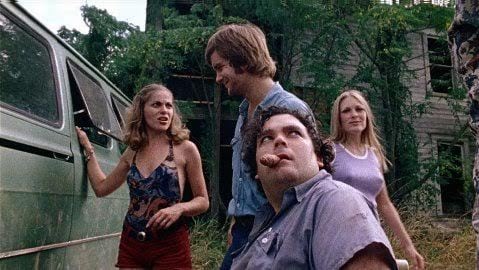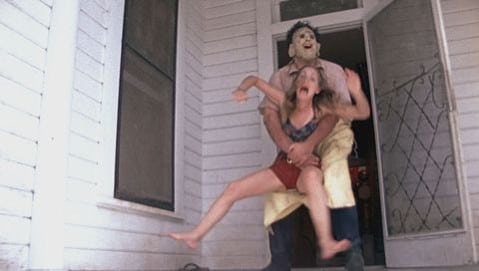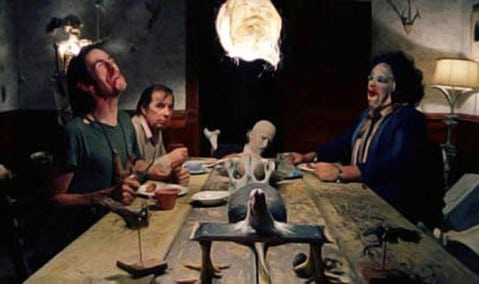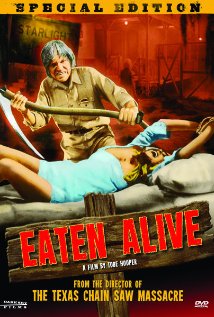The Texas Chain Saw Massacre (1974)
Directed by: Tobe Hooper
Written by: Kim Henkel, Tobe Hooper
Starring: Allen Danziger, Gunnar Hansen, Jim Siedow, Marilyn Burns
USA
AVAILABLE ON BLU-RAY AND DVD
RUNNING TIME: 83 mins
REVIEWED BY: Dr Lenera, Official HCF Critic
Sally Hardesty, her paraplegic brother Franklin, and their friends Jerry, Kirk and Pam, visit the grave of the Hardestys’ grandfather to investigate reports of vandalism and grave robbing and decide to visit the old Hardesty family homestead as well. Along the way, they pick up a hitchhiker who talks about his family who worked at the old slaughterhouse, but when they refuse to pay for a photography he takes, he burns the photo and slashes Franklin’s arm with a razor so the group forces him out of the van and drive on. They stop at a gas station to refuel, but the proprietor tells them that the pumps are empty. They continue toward the homestead and stumble upon a house….
I don’t think there’s any other film I could end this Tobe Hooper mini-retrospective with, and yet I hadn’t seen it in quite a few years, a fact that should tell you how shattering I found it the four or five times I watched it. Would it not hold up so well now, especially when viewed with older, more critical eyes, and therefore put me in the position of having to go against the majority view? After all, I’d watched and reviewed the first sequel not that long ago when Arrow Video brought it out again on Blu-ray, and didn’t find to be nearly as good as I remembered it. Well, even after just a few seconds there was no danger of that as Hooper’s masterpiece [which he never bettered, though I personally find Poltergeist to be almost as fine a film if in a very different way] already had me hooked [sorry] in the most uneasy – not to mention queasy – but powerful fashion with those quick flashes in the dark of parts of corpses and that incredible pan out from that decomposed face to reveal a corpse, holding the body of a child, drapped over a tombstone. The film reels you in immediately to its nightmarish yet horrifyingly plausible world and, just in case you’re the type not to appreciate a film like this [and in that case why would you see something called The Texas Chain Saw Massacre in the first place?] in which case it warns you of what you may be about to see – which initially makes the disgust that greeted it upon its release seem really surprising.
Whilst I didn’t read any other reviews of this film immediately prior to me writing this one, I have of course read several over the years and recent writers tend to point out the low amount of onscreen violence [this was because Hooper, unbelievably, was going for a ‘PG’ rating!] even though many critics at the time of its release pilloried it for its seemingly excessive blood and gore. I paid special attention to this element this time round and there are a few gory moments but they’re brief and most of the violence is only partly shown or not seen at all. So were all those critics watching a different film? Were those moviegoers who walked out in disgust also viewing something else? I think that the overall response, aside from being a good example of how horror movies were often treated like trash by the mainstream establishment [at least things have improved in that respect], just shows how damn frightening The Texas Chain Saw Massacre was and how well it worked. While there are quite a few horror films which I personally prefer, and while Hooper’s movie isn’t perfect, I think that this film almost represent the essence of the horror genre, or at least the essence of how the horror genre has evolved since the days of the Universal and Hammer monsters, and even if you don’t agree with that you can’t deny that it’s certainly been imitated just as much as, say, Halloween. John Carpenter’s classic may have virtually given birth to the first slasher cycle, but my eyes see little bits of The Texas Chain Saw Massacre all over the place even today [and just to get it out of the way I thought the 2003 remake, a film whose very existence I initially hated, was pretty good]. In any case, for my money, this film gets just about as close to terror as you can possibly get without actually living it, and, yes, as long as you don’t require buckets of blood and endless jump scares, it definitely still works.
Hooper got the idea for the film while standing in the hardware section of a crowded shop. While thinking of a way to get out through the crowd, he spotted the chainsaws and pondered on how useful they might be in an escape. He and Kim Henkel cowrote the screenplay while Bill Parsley, a friend of Hooper’s, provided funding. The film was made for less than $300,000 and used a cast of relatively unknown actors drawn mainly from central Texas where it was shot. Gunner Hansen turned down the soon-to-be-iconic part of Leatherface as he felt the script was too nasty, and it was co-star Marilyn Burns who talked him into doing it. The limited budget forced Hooper to film seven days a week up to 16 hours a day, so that he could finish as quickly as possible and reduce equipment rental costs. Some of the onscreen blood was actually real, Burns cutting herself in undergrowth and having her finger cut actually cut with a razor because the effects weren’t working. Every single cast member suffered some kind of injury and the film itself struggled to find a distributor. Bryanston Pictures eventually picked it up but because of a shady deal and Bryanston going bankrupt, cast and crew didn’t get fully paid until 1983 when New Line acquired the rights. It was hugely profiteable despite being banned in several countries including the UK after a limited cinema run in London. In Ottawa, Canada, two cinemas were advised by police to withdraw the film lest they face morality charges. Only in 1999 were we legally allowed to see it in the UK, though of course many of us horror fans had already owned bootleg videos for ages [I’m saying nothing].
So John Larroquette’s opening narration fraudalently [and deliberately so – Hooper seems to be getting at untruthful news reporting] leads us into the film as does the incredibly unsettling musical collage of slaughterhouse sounds. I should probably say right now that the five teenagers don’t really have much characterisation except for Franklin. Hooper and Henkel seem to be doing something quite interesting with the character – you can’t help but have some sympathy for him due to the fact that he’s in a wheelchair, yet he’s really quite unpleasant and at times you may very well want him to be killed off which creates a sense of guilt in the viewer even though he or she may not want to feel that way. Far more complex than the way many lesser slashers seem to deliberately present a bunch of would-be victims who aren’t likeable at all so you’re just cheering the killer as he polishes them off. As for the others, none of them are distinguishable from each other very much, but they do convince which is probably more important. The performers [more on Burns later] seem fairly natural speaking their mostly plausible dialogue. And technically I was truly impressed with much of the filming. This may be a gritty low budget film and it does have a few moments which might look too dark or too light or what have you, but a great deal of care was still obviously taken with the cinematography by Daniel Pearl, from the slow pans around characters from a distance [before it became a cliche] to provide a feeling of dread to the low angle shots introducing first Franklin and then a slobbering old drunk going on about how:“Things happen there, things they don’t tell about”, various variations on said scene turning up in many successive films.
The first in a long line of examples of bad luck soon comes along when the group pick up the hitchhiker, and things then go from weird to dangerous and they haveto kick him out. And the second is when they realise they are low on gas and pull into an old gas stattion, but surprise surprise the owner has ran out and the transporter won’t be by until the next morning. The owner tries to coax the kids into not visiting Sally and Franklin’s grandfather’s house, which is kind of odd if you think about it unless he’s convinced that, being teenagers, they don’t like to do as they’re told and therefore won’t follow his advice anyway. The build-up from here is superb, truly evoking a feel of the scary unknown with all those wide shots and the sound of a generator going. There’s piles of bones on doorsteps, an abandoned tent with camping gear bizarrely tied to a tree, and a loose human tooth on a front porch. And then we get one of the best introductions to a horror character ever, even though it all takes place at a distance with no quick cuts. A door covered in various skulls opens and out comes Leatherface to bash Kirk on the head. There’s no blood, but we do see Kirk’s convulsions until he’s hit again and they are almost horrible to watch. You don’t see that done very often, but this is how the death probably would be like. You don’t get much graphic detail in this film, but in a way that makes the deaths more upsetting, because there’s no special effects to marvel at, no grue for the gorehound to cheer at, just the snuffing out of lives methodically by a family who obviously do this constantly. And I’d totally forgotten about the girl in the fridge – what a shock that was!
Of course it all winds up with Sally on her own at the mercy of this family, and the tone may move to black humour a little, though personally I’ve found it all far too intense to chuckle at aside from the scene where the grandfather keeps dropping the hammer he’s supposed to bash Sally on the head which to me acts as a minute or so of comic relief before we go back to terror again. There’s clearly a scene missing, noticeable even if you didn’t know that some footage was cut, where Leatherface disappears and reappears with lipstick. And it’s possibly a bit unbelievable that Sally can jump through a window twice and then pick herself up from the ground in a second on both occasions, but the lengthy chase involving her and Leatherface is one of the very best of its kind, especially since Leatherface has the advantage of having a bloody great chainsaw which can cut through the thorn bushes while Sally has to painfully force herself through them. Sally runs in total desperation, falling over and flailng her arms, while Leatherface is just pure determination. He doesn’t do what, say, Jason Voorhees tends to do, seem to teleport himself ahead and jump out from a tree, or just stride and catch up to Sally more out of pure bad luck than anything else – he runs straight ahead. Another reason this sequence has a huge impact is because up to now everything has taken place in broad daylight and that in itself has been hugely effective because it reminds us of how people are murdered and how terrible things happen during the day all the time. When we finally switch to nightmare, the feeling of vulnerability is magnified – if we’re frightened during the day then the night must be is almost unbearable.
This evil family, even if at times coming across as a blacker than black parody of a Bible-belt family, seem totally alien to us with their weirdness, total disregard for human life and complete lack of pity, yet unlike so many of the horror bogeymen they’re actual people with a real family unit [despite the lack of females] and a sense of normalcy about the lives they lead. We even seem to be asked to partly think of this family as victims of progress, with their jobs as slaughterhouse workers been rendered obsolete by technology. Jim Siedow genuinely comes across as a family man struggling with the times and trying to make do, and yet these are truly bad people and nothing will stop them doing what they do. They don’t have a motive, this is just what they do. I know that far better writers than I have gone into the deeper themes that they see in this film though with all due respect I personally think that going into all that stuff can detract from its success as a scare machine which is what it was first and foremost intended as. Saying that though, it’s clearly informed by the malaise covering America following recent events. Everything in this film seems to be rotting away and decaying, perhaps paralleling the way society seemed to be rotten to the core, and there’s a real sense of overall hopelessness and nihilism – though this of course this is shared with many of the other revolutionary cheapie horror classics of this era like The Last House On The Left and Night Of The Living Dead. But its look and feel is unique, for goodness sake this film seems to smell different to any other film. Yet, while I’ve gone on about the minimal gore, the movie is hardly subtle elsewhere, such as the revolting detail in the house where nearly everything seems to be made out of human skin or bone. A lengthy series of pans around a disgusting room tells us all we need to know about the family’s habits just before the first killing, and this makes us feel like screaming at the characters to get out.
It’s not too easy to trace stylistic links throughout Hooper’s career, and out of the films of his that I’ve seen that he never did crazy [but in a way that enhances the situation] things like jump cuts taking us ever closer to an eye again. But then there are so many great shots in this film, like the house framed by the darkness of trees as first Sally and then Leatherface run towards the camera, or that final one of Leatherface crazily waving his chainsaw around as the sun rises. And Burns is simply phenomenal, you totally feel her total and utter fear and desperation and, despite as I’ve said her character not being very well defined in the early sections, to me she’s hands down the best ‘final girl’ in this type of horror movie even if you know that some of her pain and even terror may have been real, and shows how poor so many of the others are in depicting the kinds of emotions that would be felt. The Hooper/Wayne Bell soundtrack, mostly just sounds, really gets under the skin and a full-on score isn’t missed at all. Terrifying, uncompromising and exhausting but in the very best way, The Texas Chain Saw Massacre has lost very little of its edge and its power, and in my opinion belongs in the list of the top twenty horror films of all time, perhaps even in the top ten – and even if it’s not to certain people’s taste I don’t think that anyone can deny that it belongs in a list of the most important.











Be the first to comment